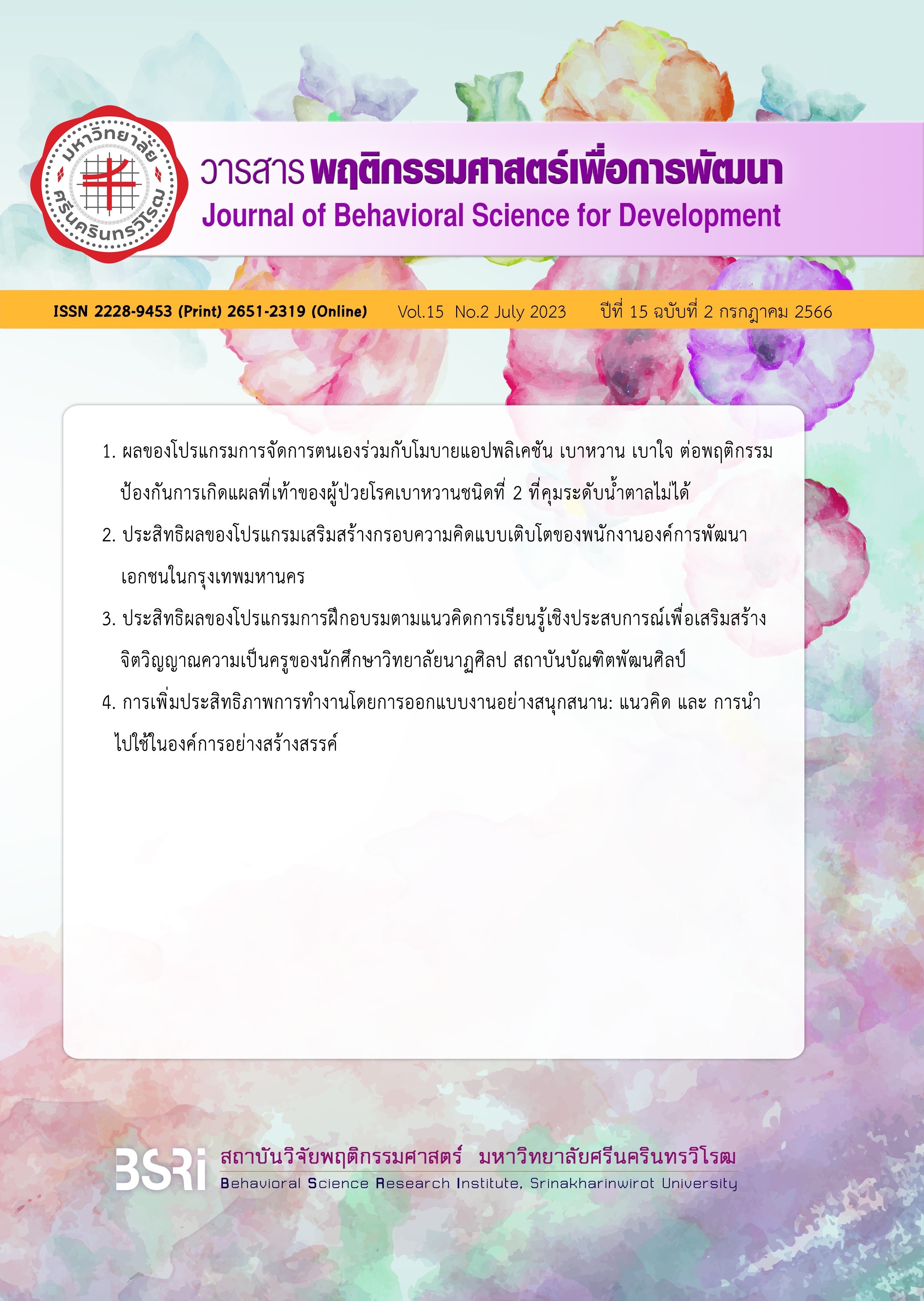Improving Work Efficiency by Playful Work Design: Concepts and Creative Application in Organizations
Keywords:
Playful work design, work design, work efficiency, job craftingAbstract
Successful work requires efficient and happy working together. Work design is one of the tools for work development that can help increase efficiency and create work satisfaction. Playful work design is a work design based on job enrichment approaches that focus on enjoying work. Employees can create a proactive, playful, and challenging work environment by designing play-like activities at work to perform for the fun and entertainment of the job. There are two important components, namely designing fun and designing competition, which are therefore important and indispensable to today's work because playful work design helps reduce boredom and burnout conditions, making work efficient as the organization sets goals. The author therefore compiles concepts and theories related to playful work design, starting work design and work efficiency concepts, understanding the meaning, related concepts, and elements of playful work design, and their application in work, in order to be a guideline for further research and development in industrial and organizational psychology, behavioral science, and other related fields.
References
Bakker, A. B., Scharp, Y. S., Breevaart, K., & de Vries, J. D. (2020a). Playful work design: Introduction of a new concept. The Spanish Journal of Psychology, 23, e19. https://doi.org/10.1017/SJP.2020.20
Bakker, A. B., Hetland, J., Olsen, O. K., Espevik, R., & de Vries, J. D. (2020b). Job crafting and playful work design: Links with performance during busy and quiet days. Journal of Vocational Behavior, 122, 103478. https://doi.org/10.1016/j.jvb.2020.103478
Bakker, A. B., & Schaufeli, W. B. (2008). Positive organizational behavior: Engaged employees in flourishing organizations. Journal of Organizational Behavior, 29, 147–154. https://doi.org/10.1002/job.515
Bakker, A. B., & Van Wingerden, J. (2021) Rumination about COVID-19 and employee well-being: The role of playful work design. Canadian Psychology/Psychologie Canadienne, 62(1), 73–79.
Barnett, L. A. (2007). The nature of playfulness in young adults. Personality and Individual Differences, 43, 949–958. http://doi.org/10.1016/j.paid.2007.02.018
Bhattacharya, S., & Gandhi, A. (2020). Engaging the Head, Heart and Hand of the Millennial Workforce. Psychological Studies, 65(4), 429–444. https://doi.org/10.1007/s12646-020-00577-5
Campion, M. A. (1988). Interdisciplinary approaches to job design: A constructive replication with extensions. Journal of Applied Psychology, 73(3), 467–481. https://doi.org/10.1037/0021-9010.73.3.467
Csikszentmihalyi, M. (2020). Finding flow: The psychology of engagement with everyday life. Hachette UK.
Donaldson, S. I., Lee, J. Y., & Donaldson, S. I. (2019). Evaluating positive psychology interventions at work: A systematic review and meta-analysis. International Journal of Applied Positive Psychology, 4, 113–134. https://doi.org/10.1007/s41042-019-00021-8
Fried, Y., Levi, A., & Hadani, M. (2017). Job Design. In Rogelberg, S. (Ed.). The SAGE encyclopedia of industrial and organizational psychology (Vols. 2) (2nd Ed.). pp. 786-790. SAGE Publications, Inc. https://doi.org/10.4135/9781483386874
Fisher, C.D. (2017). Boredom at Work. In Rogelberg, S. (Ed.). The SAGE encyclopedia of industrial and organizational psychology (Vols. 1) (2nd Ed.). pp. 130-132. SAGE Publications, Inc. https://doi.org/10.4135/9781483386874
Hackman, J.R., Oldham, G.R., Janson, R., & Purdy, K. (1975). A new strategy for job enrichment. California Management Review, 17(4), 57-71.
Hackman, J.R., & Oldham, G. R. (1976). Motivation through the design of work: test of a theory. Organizational Behavior and Human Performance, 16(2), 250–279. https://doi.org/10.1016/0030-5073(76)90016-7
Hayman, J. R. (2009). Flexible work arrangements: exploring the linkages between perceived usability of flexible work schedules and work/life balance. Community, Work & Family, 12(3), 327–338. https://doi.org/10.1080/13668800902966331
Ivanaj, V., Poldner, K., & Shrivastava, P. (2014). HAND / HEART / HEAD: Aesthetic Practice Pedagogy for Deep Sustainability Learning. Journal of Corporate Citizenship, 2014(54), 23–46. https://doi.org/10.9774/gleaf.4700.2014.ju.00005
Liu, W., Bakker, A. B., Tse, B. T., & van der Linden, D. (2022). Does playful work design ‘lead to’ more creativity? A diary study on the role of flow. European Journal of Work and Organizational Psychology, 32(1), 107–117. https://doi.org/10.1080/1359432x.2022.2104716
Morgeson, F.P. & Campion, M.A. (2003). Work Design. In Irving B. Weiner (Ed). Handbook of Psychology: Industrial and Organizational Psychology (Vols. 12). pp. 423- .452. John Wiley & Sons.
Oprea, B.T., Barzin,L., Vîrgă, D., Lliescu, D. & Rusu, A. (2019). Effectiveness of job crafting interventions: A meta-analysis and utility analysis. European Journal of Work and Organizational Psychology, 28(6), 723-741. https://doi.org/10.1080/1359432X.2019.1646728
Parker, S. K., & Collins, C. G. (2010). Taking stock: Integrating and differentiating multiple proactive behaviors. Journal of Management, 36(3), 633– 662. https://doi.org/10.1177/0149206308321554
Parker, S. K., Morgeson, F. P., & Johns, G. (2017). One hundred years of work design research: Looking back and looking forward. Journal of Applied Psychology, 102(3), 403–420. https://doi.org/10.1037/apl0000106
Parker, S., & Wall, T. (1998). Job and work design: Organizing work to promote well-being and effectiveness. Thousand Oaks: Sage. https://doi.org/10.4135/9781452231518
Santrock, J. W. (2006). Life-span development (10th ed.). McGraw-Hill.
Scharp, Y. S., Breevaart, K., Bakker, A. B., & van der Linden, D. (2019). Daily playful work design: A trait activation perspective. Journal of Research in Personality, 82, 103850. https://doi.org/10.1016/j.jrp.2019.103850
Scharp, Y. S., Breevaart, K., & Bakker, A. B. (2021). Using playful work design to deal with hindrance job demands: A quantitative diary study. Journal of Occupational Health Psychology, 26(3), 175–188. https://doi.org/10.1037/ocp0000277
Scharp, Y. S., Bakker, A. B., Breevaart, K., Kruup, K., & Uusberg, A. (2022). Playful work design: Conceptualization, measurement, and validity. Human Relations, 76(4), 509–550. https://doi.org/10.1177/00187267211070996
Schaufeli, W. B., Martinez, I. M., Pinto, A. M., Salanova, M., & Barker, A. B. (2002). Burnout and engagement in university students a cross-national study. Journal of Cross-Cultural Psychology, 33(5), 464–481. https://doi.org/10.1177/002202210203300500
Truxillo, D. M., Bauer, T. N., & Erdogan, B. (2021). Psychology and Work: An Introduction to Industrial and Organizational Psychology (2nd Ed.). Routledge. https://doi.org/10.4324/9780429055843
Warr, P. (2007). Work, Happiness, and Unhappiness. Psychology Press. https://doi.org/10.1604/9780805857108
Downloads
Published
How to Cite
Issue
Section
License
Copyright (c) 2023 Journal of Behavioral Science for Development

This work is licensed under a Creative Commons Attribution-NonCommercial-NoDerivatives 4.0 International License.




